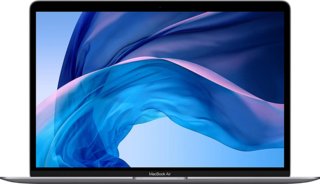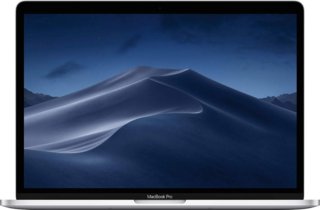Apple MacBook Air (2020) 13.3" Intel Core i3 vs Apple MacBook Pro (2019) 13" Intel Core i5 1.4GHz 8GB RAM 256GB SSD
In the high-tech industry, Apple consistently raises standards with its outstanding MacBook series. Today, we're comparing two stylish models: the 2020 MacBook Air and the 2019 MacBook Pro. Both feature a stunning 13-inch display, but they are far from identical. Beneath their attractive surfaces, each model possesses distinct advantages and features. Whether you're an enthusiastic gamer or a digital artist, your ideal laptop may be only one comparison away. Let's delve into how these two MacBooks compare in performance, design, durability, and much more!
System and application performance
Performance in popular 3D games
Viewing angle, color accuracy...
Ports, webcam and other interfaces
Potential battery life
Materials, durability and portability
Design Comparison
Size Comparison
Comparing the Apple MacBook Air (2020) and the Apple MacBook Pro (2019) reveals key design differences that greatly influence user experience. Understanding how each laptop meets distinct needs and preferences can aid potential buyers in making informed decisions.
Design Elements Enhancing User Experience:
Ergonomics:
- Users on-the-go will appreciate the excellent portability of both laptops, weighing less than 3 pounds.
- The compact dimensions of 12 x 8.4 x 0.6 inches make it easy to carry and fit into most bags.
Materials and Build Quality:
- Both models feature Apple's signature high-quality aluminum construction, ensuring durability and a premium feel.
- Both laptops feature a sleek design that appeals to professionals and students with a modern aesthetic.
Portability:
- These lightweight laptops are perfect for those who value portability while still needing high performance.
- The slim design makes it easy to handle and transport, ideal for users who frequently need to move around.
Unique Design Features:
- Both laptops come with backlit keyboards, improving usability in low-light settings.
- Multiple USB-C ports, Thunderbolt ports, stereo speakers, an audio jack, front camera, and fingerprint scanner are included to provide versatility and convenience for a variety of tasks.
Practical Usability and Aesthetic Appeal:
- Students: The lightweight design and compact size make these laptops perfect for students who need portability without sacrificing power. The backlit keyboard aids late-night study sessions.
- Professionals: The premium materials, sleek aesthetics, and robust build quality cater to professionals seeking a reliable device for work-related tasks. The inclusion of multiple connectivity options enhances productivity.
Impact on Overall Experience and Value:
- These design features create a smooth user experience by blending functionality with style.
- The MacBook Air focuses on portability with its lightweight design, while the MacBook Pro prioritizes performance with a slightly heavier construction.
Screen Comparison
| Apple MacBook Air (2020) 13.3" Intel Core i3 | Apple MacBook Pro (2019) 13" Intel Core i5 1.4GHz 8GB RAM 256GB SSD | |
|---|---|---|
| Resolution | QHD | QHD |
| Screen Size | 13.3" | 13" |
The Apple MacBook Air (2020) and the Apple MacBook Pro (2019) are equipped with 13.3-inch displays boasting a resolution of 2560 x 1440 pixels, providing a pixel density of 227 pixels per inch (ppi). This results in clear and detailed images, ensuring text and graphics are sharp and vivid.
Screen Size:
- Both laptops feature a 13.3-inch screen size, striking a balance between portability and screen space. Their compact design makes them ideal for working on the move, providing ample viewing comfort.
Display Technology:
- The MacBook Air (2020) and MacBook Pro (2019) both use IPS LCD panels with LED-backlit technology, providing vibrant colors, wide viewing angles, and energy-efficient performance. IPS technology ensures precise color reproduction and consistent brightness levels across the screen, ideal for tasks like graphic design or photo editing.
Brightness: The MacBook Pro (2019) has a brightness level of 500 nits, higher than that of the MacBook Air (2020). This added brightness can be advantageous in well-lit areas or outdoor settings where glare could pose a problem, improving visibility across different lighting conditions.
Impact on Tasks:
- Gaming: Both laptops have high-resolution displays ideal for gaming. The MacBook Pro's higher brightness may provide a slight edge in enhancing visibility when playing games in well-lit environments.
- For professional graphic design: The IPS technology on both laptops ensures color accuracy and consistency, ideal for professional graphic design tasks. The MacBook Pro's higher brightness can enhance clarity when working on detailed projects in well-lit environments.
In summary, both laptops feature impressive screens with sharp resolutions and excellent color reproduction thanks to their IPS LCD displays. The MacBook Pro's higher brightness level can be beneficial for tasks in well-lit environments, yet both laptops are suitable for gaming and professional graphic design work.
Hardware Comparison
| Apple MacBook Air (2020) 13.3" Intel Core i3 | Apple MacBook Pro (2019) 13" Intel Core i5 1.4GHz 8GB RAM 256GB SSD | |
|---|---|---|
| CPU | Intel Core i3 | Intel Core i5 |
| RAM | 8GB | 8GB |
| Storage Size | 256GB | 256GB |
Comparing the hardware aspects of the Apple MacBook Air (2020) 13.3" Intel Core i3 1.1GHz / 8GB RAM / 256 GB SSD and the Apple MacBook Pro (2019) 13" Intel Core i5 1.4GHz / 8GB RAM / 256GB SSD involves assessing key components to aid your decision-making process.
CPUMacBook Air (2020): Equipped with an Intel Core i3 processor running at 1.1GHz, capable of turbo boosting up to 3.2GHz.
- MacBook Pro (2019): Comes with an Intel Core i5 processor clocked at 1.4GHz, with the ability to turbo boost up to 3.9GHz.
Performance Impact:
- The MacBook Pro's increased base and turbo clock speeds deliver superior performance for tasks requiring more processing power, like video editing or running numerous applications at once.
GPU
- The laptops use integrated graphics processing units (iGPUs) integrated within the Intel processors.
Performance Impact:
- For basic multimedia tasks like streaming videos or light photo editing, both laptops provide satisfactory performance due to their integrated GPUs.
RAM
- Both models come with 8GB of RAM, each offering different speeds.
- MacBook Air (2020): Features faster RAM speed at 3733 MHz, outperforming the MacBook Pro (2019) which runs at 2133 MHz.
Performance Impact:
- The MacBook Air's higher RAM speed results in smoother multitasking and improved performance when running multiple applications at once, surpassing the capabilities of the MacBook Pro.
Storage
- Both laptops come with a standard internal storage capacity of 256GB using flash storage technology.
Performance Impact:
- Flash storage ensures faster boot times and application launch speeds on both laptops, contributing to a snappy user experience.
In summary:
MacBook Air (2020)- Ideal for daily activities such as browsing the web, working with documents, and basic photo editing.
- Faster RAM speed aids in multitasking efficiency.
- Good choice for casual users seeking portability without compromising on performance.
MacBook Pro (2019)
- Ideal for users requiring more processing power for demanding tasks like video editing or software development.
- Higher CPU clock speeds provide better performance under heavy workloads.
- Reliable option for professionals needing robust computing capabilities.
In summary, if you value portability and daily use over demanding tasks, the MacBook Air is a reliable option. On the other hand, if you need increased performance for challenging applications or multitasking needs, the MacBook Pro is a better choice.
Battery Comparison
| Apple MacBook Air (2020) 13.3" Intel Core i3 | Apple MacBook Pro (2019) 13" Intel Core i5 1.4GHz 8GB RAM 256GB SSD | |
|---|---|---|
| Battery Life | 11 hours | 10 hours |
Comparing the battery performance of the Apple MacBook Air (2020) 13.3" with an Intel Core i3 processor to the Apple MacBook Pro (2019) 13" with an Intel Core i5 chip reveals significant differences.
Apple MacBook Air (2020) 13.3" featuring Intel Core i3 1.1GHz:
Battery Life: Users of the MacBook Air can enjoy up to 11 hours of battery life on a single charge, allowing for prolonged use without the hassle of frequent recharging.
- Sleep And Charge USB Ports: Users can easily charge their devices while the laptop is in sleep mode, adding to its convenience and usability.
Apple MacBook Pro (2019) 13" with Intel Core i5 1.4GHz:
- Battery Life: The MacBook Pro offers a 10-hour battery life, slightly shorter than the Air but still providing a decent amount of usage time.
- Sleep And Charge USB Ports: Just like the MacBook Air, the Pro model also features Sleep and Charge USB ports, allowing users to charge external devices while the laptop is in sleep mode.
Both laptops deliver excellent battery performance and feature handy Sleep and Charge USB ports. However, the Apple MacBook Air (2020) offers a slightly longer battery life with up to 11 hours compared to the MacBook Pro's 10 hours. If all-day productivity on a single charge is essential for you, this extra hour could be a significant advantage.
Verdict
Why Apple MacBook Air (2020) 13.3" Intel Core i3?
- Longer battery life of up to 11 hours on a single charge.
- Faster RAM speed at 3733 MHz for smoother multitasking.
- Ideal for daily activities and casual users prioritizing portability.
Why ?
- The MacBook Pro offers superior performance for demanding tasks like video editing or software development.
- Higher CPU clock speeds provide better processing power under heavy workloads.
- Ideal choice for professionals needing robust computing capabilities.
- Reliable option for users requiring increased performance and multitasking efficiency.
Similar comparisons
- Apple MacBook Air (2020) 13.3" Intel Core i3 vs Apple MacBook Pro (2017) 13" with Touch Bar and Touch ID / Intel Core i5 256GB
- Apple MacBook (2016) vs Apple MacBook Air (2020) 13.3" Intel Core i3
- Apple MacBook Air (2020) 13.3" Apple M1 vs Razer Blade Stealth RZ09 12.5" Intel Core i7-6500U
- Apple MacBook Air (2020) 13.3" Apple M1 vs Microsoft Surface Pro 6
- Apple MacBook Air (2020) 13.3" Apple M1 vs Lenovo ThinkPad T450s 14" Intel Core i5-5200U

